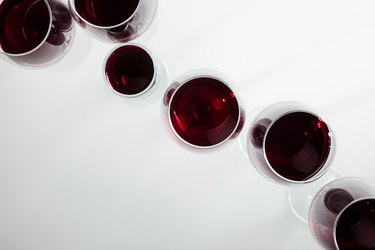 Can I Still Drink Expired Red Wine? Image Credit: LightFieldStudios/iStock/GettyImages
Can I Still Drink Expired Red Wine? Image Credit: LightFieldStudios/iStock/GettyImages
Whether you're just beginning to enjoy wine or you are an avid collector, the question of whether or not it's alright to drink expired red wine is a common one. Varied life expectancies of red wine cause varietals to age differently, but the good news is that drinking red wine that has gone bad won't hurt you. The vintage will just not taste right if it has reached the end of its wine shelf life. A full understanding of red wine itself, and what to expect when opening a bottle, can help you decide if you should drink your bottle.
Video of the Day
Try Not to Panic
If your wine tasted off when you drank it, should you be on the lookout for drinking bad wine symptoms? Probably not. Expiration dates imply that after a certain point, a product has gone bad and will cause harm if ingested. Wine bottles do not display a sell-by date or an expiration date indicating an official end to a particular wine shelf life. That's because drinking expired wine doesn't actually harm you. If you taste a bottle of red that has gone bad, you know – immediately – that it's not the right bottle to serve. The taste, smell and appearance are off. So, although you can drink expired wine – you probably shouldn't.
Determine the Wine Shelf Life
Most of the time, you can tell by the wine's appearance that it has gone bad. A leaky cork means that the seal on the wine is not good. When a wine isn't sealed, oxygen has gotten into the bottle, aging and oxidizing the wine. Just as air exposure causes metal to rust, oxygen breaks down parts of the wine, creating a bad taste. Spoiled wine usually looks cloudy or foggy, and may be tinted a brownish-red color. If your red wine tastes either vinegary or moldy, it's gone bad. For this reason, the hunt for drinking bad wine symptoms will have more to do with the spoiled taste of the wine itself, rather than with any real health risks to you.
Learn Each Wine’s Characteristics
Red wine includes the varietals merlot, cabernet sauvignon, claret and pinot noir. Although red wine varies from grape to grape, and region to region, each varietal carries similar characteristics. Red wines display flavors of red or black fruit such as raspberry, blackberry, cherry, blueberry, and stone fruit such as plums. It is drier than white wine, which tends to be sweeter. Cooler climate red wines have an elevated acidity: that tingly sensation at the front of your mouth that leaves your tongue feeling rough after drinking. Red wine commonly has more of a bite than white or blush wines, but only expired red wine will taste like a musty basement or a bottle of vinegar.
Forget the Misconceptions
Most wines aren't meant to be cellared, or stored, for many years at a time. The notes on the back of the bottle or on the winery's website will let you know the optimum storage time for your red wine. On average, red varietals store well for anywhere from two to five years. Premium wines are sometimes crafted to last longer, but most of the red wines available on the market are good right off the shelf. Some wineries prefer to leave their wines unfiltered. If you see small particles floating in your wine, or if the wine has a cloudy look, it may not actually be bad. The wine label will state if the wine is unfiltered so you know what to expect from the bottle.










































